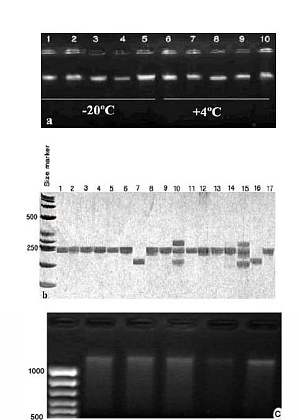Non_destructive_Biotechniques_2004art.pdf
Tissue preparation We used FFPE tissue blocks of Non-small cell lung cancer obtained from Pathology department of Kerman Medical University which were fixed from 2004 to 2006. Before outset of our exa ...
Non_destructive_Biotechniques_2004art.pdf
Meyerowitz et. al. (~1987ish) A. thaliana has a very small haploid genome and this makes obtaining DNA somewhat difficult. The most notable problem is that DNA is usually contaminated with polysacchar ...
Nuclei isolation modified from Hamilton Kunsch and Temperli (1972) Anal. Biochem. 49:48-57; further modified by Tom Guilfoyle then N. Olszewski and Eric Richards. Procedure: (all steps at 0-4C unless ...
Meyerowitz et. al. (~1987ish) A. thaliana has a very small haploid genome and this makes obtaining DNA somewhat difficult. The most notable problem is that DNA is usually contaminated with polysacchar ...
Nuclei isolation modified from Hamilton Kunsch and Temperli (1972) Anal. Biochem. 49:48-57; further modified by Tom Guilfoyle then N. Olszewski and Eric Richards. Procedure: (all steps at 0-4C unless ...
Use fresh or Lyophilize the leaf tissue. Grind about 5 g leaf tissue with mortar and pestle in liquid N2 transfer the powder into an 50 ml polypropylene tube (50 ml) and store at -20°C. Add 25 ml of ...
This protocol originated in Murray and Thompson (1980) and then was modified by Richard Jorgensen and finally published in Wagner et. al 1987.Start with about 10 grams fresh needles. Chop into short ...
CTAB TECHNIQUE / Method / Schedule / Protocol FOR DNA ISOLATION / DNA EXTRACTION FROM PLANT LEAF / LEAVES SAMPLES (see also DNA RNA double isolation procedure if both DNA and RNA are needed) Reagents ...
Use from 0.01 - 0.1 gram plant material. Grind the plant material with liq. N2 in a mortar. We normally use some alumina to crush hard tissue. Transfer the ground tissue to a eppendorf tube. Add 1 ml ...
Plant_Leaf_DNA_Extraction.pdf
Plant_Leaf_DNA_Extraction.pdf
Preheat Extraction Buffer at 60°C. Weigh 100 mg of fresh leaf tissue and grind it to powder in Liquid Nitrogen in a chilled mortar and pestle. Add 0.5 ml of TE buffer to the tube. Centrifuge at 500 g ...
Grow Rhizobium cells in 5 ml of YEMB at 200 rpm till the O.D (600 nm) reaches 0.6-0.8. Pellet the cells by centrifugation at 10000 rpm for 15 mins. Wash the pellet with TE buffer (10T/1E). Dissolve th ...
Phenol Chloroform Absolute ethanol 70% ethanol TE buffer (10T/1E) pH 8.0 10% SDS 50 mg/ml lysozyme 5 M NaCl ProcedureMacerate Cyanobacteria in TE Buffer (10T/1E) Pellet the cells by centrifugation for ...
Procedure:1) Use Pharmacia #27-4564-01. With clean flamed scissors and forceps weigh 0.25 g/50 ml conical and add 50 ml/conical of 0.02 M Tris pH 7.6. Allow to dissolve over several days at 4°C.2) ...
PCR-based methods are widely used in plants and animals for marker-assisted breeding and high-resolution mapping. These studies require analysis of large number of samples thus a DNA extraction method ...
Take an oral smear Dissolve in 50 ml H2O through vigorous shaking Pellet cells 5 min at 4000 rpm Re-suspended the pellet in 400 μl Lysis buffer (50 mM TRIS-Cl pH 8 10 mM EDTA 2% SDS) Incubate for 5 mi ...
A nested series of deletions can be produced by: cutting plasmid DNA (2.5ug per time point see below) with an enzyme leaving a blunt (eg EcoRV) or 5'' overhand (eg EcoRI) on the side that the deletion ...










